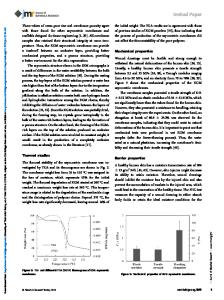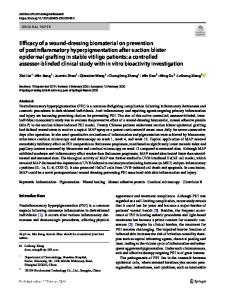A novel and facile prepared wound dressing based on large expanded graphite worms
- PDF / 1,031,232 Bytes
- 10 Pages / 584.957 x 782.986 pts Page_size
- 20 Downloads / 320 Views
A novel and facile prepared wound dressing based on large expanded graphite worms Zhongqun Liu1, Yishan Hao2, Yijun Su1, Yaojie Wei1, Jingyun Wang1, Hao Yan1, Wanci Shen3, Zhenghong Huang3, Xiumei Wang1, Lingyun Zhao1,b), Xiaodan Sun1,a) 1 State Key Laboratory of New Ceramics and Fine Processing, School of Materials Science and Engineering, Tsinghua University, Beijing 100084, People’s Republic of China; and Key Laboratory of Advanced Materials of Ministry of Education of China, School of Materials Science and Engineering, Tsinghua University, Beijing 100084, Peoples R China 2 Guanghua School of Stomatology, Hospital of Stomatology, Guangdong Provincial Key Laboratory of Stomatology, Sun Yat-sen University, Guangzhou, Guangdong Province 510055, Peoples R China 3 Key Laboratory of Advanced Materials of Ministry of Education of China, School of Materials Science and Engineering, Tsinghua University, Beijing 100084, Peoples R China a) Address all correspondence to these authors. e-mail: [email protected] b) e-mail: [email protected]
Received: 15 June 2018; accepted: 20 November 2018
As rarely large flake graphite (9 mesh) was recently exploited in China, it was innovatively developed as the raw material to prepare a novel wound dressing based on large expanded graphite (EG) in this work. The EG worms were prepared in an easy oxidative intercalation and thermal expansion method. Afterward, chitosan was grafted onto the surface of EG by chemical modification, forming CS-EG worms. CS-EG sponge dressings were then obtained by pressing a number of CS-EG worms together by external force. Due to the porous structure and large specific surface area, the produced CS-EG sponges exhibited outstanding adsorption capacity for wound exudate. They could also promote blood coagulation by adsorbing the blood cells and proteins quickly and effectively, showing excellent hemostatic performance. The eminent performances and the simple preparation process ensure the great application potential of CS-EG as a dressing material. This is also the first time to report the application of the traditional carbon material, EG, to act as a dressing material after chemical modification.
Introduction Cost on wound healing treatment is reported to be over $25 million every year in the world [1]. The wound dressing is necessary for the wound treatment and provides an ideal environment for wound healing. However, shortcomings of dressings in market, such as lack of porosity and adhesion onto the wound surface [2], are challenges to wound care. Economical and versatile alternatives to traditional dressings should be exploited. Currently, there are hundreds of dressings on the market aiding in wound management, including films [3, 4], hydrogels [3, 5, 6], hydrocolloids [3, 7, 8], alginates [3, 9, 10], and foams [3, 11, 12]. To treat the wound effectively, dressings are required to be applied on the wound during the healing process. It has been known that the wound healing process can be divided into five stages: hemostasis, inflamm
Data Loading...











